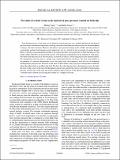| dc.contributor.author | Yang, Zhibing | |
| dc.contributor.author | Juanes, Ruben | |
| dc.date.accessioned | 2018-03-27T18:01:29Z | |
| dc.date.available | 2018-03-27T18:01:29Z | |
| dc.date.issued | 2018-02 | |
| dc.date.submitted | 2017-11 | |
| dc.identifier.issn | 2470-0045 | |
| dc.identifier.issn | 2470-0053 | |
| dc.identifier.uri | http://hdl.handle.net/1721.1/114410 | |
| dc.description.abstract | Pore fluid pressure in a fault zone can be altered by natural processes (e.g., mineral dehydration and thermal pressurization) and industrial operations involving subsurface fluid injection and extraction for the development of energy and water resources. However, the effect of pore pressure change on the stability and slip motion of a preexisting geologic fault remains poorly understood; yet, it is critical for the assessment of seismic hazard. Here, we develop a micromechanical model to investigate the effect of pore pressure on fault slip behavior. The model couples fluid flow on the network of pores with mechanical deformation of the skeleton of solid grains. Pore fluid exerts pressure force onto the grains, the motion of which is solved using the discrete element method. We conceptualize the fault zone as a gouge layer sandwiched between two blocks. We study fault stability in the presence of a pressure discontinuity across the gouge layer and compare it with the case of continuous (homogeneous) pore pressure. We focus on the onset of shear failure in the gouge layer and reproduce conditions where the failure plane is parallel to the fault. We show that when the pressure is discontinuous across the fault, the onset of slip occurs on the side with the higher pore pressure, and that this onset is controlled by the maximum pressure on both sides of the fault. The results shed new light on the use of the effective stress principle and the Coulomb failure criterion in evaluating the stability of a complex fault zone. | en_US |
| dc.description.sponsorship | United States. Department of Energy (Award DE-SC0018357) | en_US |
| dc.description.sponsorship | United States. Department of Energy (Award DE-FE0009738) | en_US |
| dc.publisher | American Physical Society | en_US |
| dc.relation.isversionof | http://dx.doi.org/10.1103/PhysRevE.97.022906 | en_US |
| dc.rights | Article is made available in accordance with the publisher's policy and may be subject to US copyright law. Please refer to the publisher's site for terms of use. | en_US |
| dc.source | American Physical Society | en_US |
| dc.title | Two sides of a fault: Grain-scale analysis of pore pressure control on fault slip | en_US |
| dc.type | Article | en_US |
| dc.identifier.citation | Yang, Zhibing and Ruben Juanes. "Two sides of a fault: Grain-scale analysis of pore pressure control on fault slip." Physical Review E 97, 2 (February 2018): 022906 © 2018 American Physical Society | en_US |
| dc.contributor.department | Massachusetts Institute of Technology. Department of Civil and Environmental Engineering | en_US |
| dc.contributor.department | Massachusetts Institute of Technology. Department of Earth, Atmospheric, and Planetary Sciences | en_US |
| dc.contributor.mitauthor | Yang, Zhibing | |
| dc.contributor.mitauthor | Juanes, Ruben | |
| dc.relation.journal | Physical Review E | en_US |
| dc.eprint.version | Final published version | en_US |
| dc.type.uri | http://purl.org/eprint/type/JournalArticle | en_US |
| eprint.status | http://purl.org/eprint/status/PeerReviewed | en_US |
| dc.date.updated | 2018-02-21T18:01:08Z | |
| dc.language.rfc3066 | en | |
| dspace.orderedauthors | Yang, Zhibing; Juanes, Ruben | en_US |
| dspace.embargo.terms | N | en_US |
| dc.identifier.orcid | https://orcid.org/0000-0002-2296-050X | |
| dc.identifier.orcid | https://orcid.org/0000-0002-7370-2332 | |
| mit.license | PUBLISHER_POLICY | en_US |
